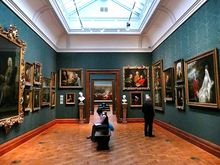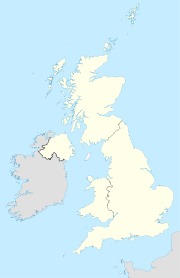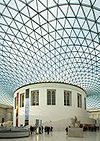- National Portrait Gallery, London
-
Coordinates: 51°30′34″N 0°07′40″W / 51.509369°N 0.127733°W
National Portrait Gallery
Entrance to the National Portrait GalleryEstablished 1856 Location St Martin's Place, WC2, England Collection size 10,000 portraits Visitor figures 1,961,843 (2009)[1]
Director Sandy Nairne Public transit access Charing Cross 
Embankment __ __ _( _ __( _( _((
 Charing Cross 100m)
Charing Cross 100m)
Leicester SquareWebsite www.npg.org.uk The National Portrait Gallery is an art gallery in London, England, housing a collection of portraits of historically important and famous British people. It was the first portrait gallery in the world when it opened in 1856.[2] The gallery moved in 1896 to its current site at St Martin's Place, off Trafalgar Square, and adjoining the National Gallery. It has been expanded twice since then. The National Portrait Gallery (NPG) also has three regional outposts at Beningbrough Hall, Bodelwyddan Castle and Montacute House. It is unconnected to the Scottish National Portrait Gallery in Edinburgh, with which its remit overlaps. The gallery is a non-departmental public body sponsored by the Department for Culture, Media and Sport.
Contents
The collection
The gallery houses portraits of historically important and famous British people, selected on the basis of the significance of the sitter, not that of the artist. The collection includes photographs and caricatures as well as paintings, drawings and sculpture.[3] One of its best-known images is the Chandos portrait, the most famous portrait of William Shakespeare[4] although there is some uncertainty as to if the painting actually is of the playwright.[5]
Not all of the portraits are exceptional artistically, although there are self-portraits by William Hogarth, Sir Joshua Reynolds and other British artists of note. Some, such as the group portrait of the participants in the Somerset House Conference of 1604, are important historical documents in their own right. Often the curiosity value is greater than the artistic worth of a work, as in the case of the anamorphic portrait of Edward VI by William Scrots, Patrick Branwell Brontë's painting of his sisters Charlotte, Emily and Anne, or a sculpture of Queen Victoria and Prince Albert in medieval costume. Portraits of living figures were allowed from 1969. In addition to its permanent galleries of historical portraits, the National Portrait Gallery exhibits a rapidly changing collection of contemporary work, stages exhibitions of portrait art by individual artists and hosts the annual BP Portrait Prize competition.
History and buildings
The locations of the NPG and its three outposts.The three people largely responsible for the founding of the National Portrait Gallery are commemorated with busts over the main entrance. At centre is Philip Henry Stanhope, 5th Earl Stanhope, with his supporters on either side, Thomas Babington Macaulay, 1st Baron Macaulay (to Stanhope's left) and Thomas Carlyle (to Stanhope's right). It was Stanhope who, in 1846 as a Member of Parliament (MP), first proposed the idea of a National Portrait Gallery. It was not until his third attempt, in 1856, this time from the House of Lords, that the proposal was accepted. With Queen Victoria's approval, the House of Commons set aside a sum of £2000 to establish the gallery. As well as Stanhope and Macaulay, the founder Trustees included Benjamin Disraeli and Lord Ellesmere. It was the latter who donated the Chandos portrait to the nation as the gallery's first portrait. Carlyle became a trustee after the death of Ellesmere in 1857.[6]
For the first 40 years, the gallery was housed in various locations in London. The first 13 years were spent at 29 Great George Street, Westminster. There, the collection increased in size from 57 to 208 items, and the number of visitors from 5,300 to 34,500. In 1869, the collection moved to Exhibition Road and buildings managed by the Royal Horticultural Society. Following a fire in those buildings, the collection was moved in 1885, this time to the Bethnal Green Museum. This location was ultimately unsuitable due to its distance from the West End, condensation and lack of waterproofing. Following calls for a new location to be found, the government accepted an offer of funds from the philanthropist William Henry Alexander. Alexander donated £60,000 followed by another £20,000, and also chose the architect, Ewan Christian. The government provided the new site, St Martin's Place, adjacent to the National Gallery, and £16,000.[6] The buildings, faced in Portland stone, were constructed by Shillitoe & Son.[7] Both the architect, Ewan Christian, and the gallery's first director, George Scharf, died shortly before the new building was completed. The gallery opened at its new location on 4 April 1896.[6]
The site has since been expanded twice. The first extension, in 1933, was funded by Lord Duveen, and resulted in the wing by architect Sir Richard Allison[8] that runs along Orange Street.
The second extension was funded by Sir Christopher Ondaatje and a £12m Heritage Lottery Fund grant, and was designed by London based architects Edward Jones and Jeremy Dixon.[9] The Ondaatje Wing opened in 2000 and occupies a narrow space of land between the two 19th-century buildings of the National Gallery and the National Portrait Gallery, and is notable for its immense, two-storey escalator that takes visitors to the earliest part of the collection, the Tudor portraits.
In January 2008, the Gallery received its largest single donation to date, a £5m gift from Aston Villa Chairman and U.S. billionaire Randy Lerner.
Exterior busts
In addition to the busts of the three founders of the gallery over the entrance, the exterior of two of the original 1896 buildings are decorated with stone block busts of eminent portrait artists, biographical writers and historians. These busts, sculpted by Frederick R. Thomas, depict James Granger, William Faithorne, Edmund Lodge, Thomas Fuller, The Earl of Clarendon, Horace Walpole, Hans Holbein the Younger, Sir Anthony Van Dyck, Sir Peter Lely, Sir Godfrey Kneller, Louis François Roubiliac, William Hogarth, Sir Joshua Reynolds, Sir Thomas Lawrence and Sir Francis Chantrey.[6]
Finances and staff
The National Portrait Gallery's total income in 2007-2008 amounted to £16,610,000, the majority of which came from government grant-in-aid (£7,038,000) and donations (£4,117,000).[10] As of 31 March 2008, it's net assets amounted to £69,251,000.[10] In 2008, the NPG had 218 full-time equivalent employees.[10] It is an exempt charity under English law.[11]
Directors
- 1857-1895 George Scharf
- 1895-1909 Lionel Cust – previously at the Department of Prints and Drawings at the British Museum, and from 1901 to 1927 filled the role of Surveyor of the King's Pictures.
- 1909-1916 Charles John Holmes – Later director of the National Gallery
- 1917-1927 James Milner
- 1927-1951 Henry Hake[12][13]
- 1951-1964 Charles Kingsley Adams[14]
- 1964-1967 David Piper – Later director of the Fitzwilliam Museum and fellow of Christ's College, Cambridge (1967–1973), and first director of the Ashmolean Museum (1973–1985)
- 1967-1973 Roy Strong
- 1974-1994 John Hayes
- 1994-2002 Charles Saumarez Smith
- 2002-present Sandy Nairne
Legal threat against Wikipedia volunteer
Main article: National Portrait Gallery copyright conflictsOn 14 July 2009, the National Portrait Gallery sent a demand letter alleging breach of copyright against an editor-user of Wikipedia, who downloaded thousands of high-resolution reproductions of public domain paintings from the NPG website, and placed them on Wikipedia's sister media repository site, Wikimedia Commons.[15][16]The user "found a way to get around their software and download hi-resolution images without permission."[15]
1909 murder-suicide
In newly released papers belonging to Sir George Scharf, the gallery's first director, the details of a 1909 murder-suicide in the public gallery have been revealed. A man, having shot his wife, turned the gun on himself shortly after they had been witnessed viewing portraits together.[17]
See also
References
- ^ "VISITS MADE IN 2009 TO VISITOR ATTRACTIONS IN MEMBERSHIP WITH ALVA". Association of Leading Visitor Attractions. http://www.alva.org.uk/visitor_statistics/. Retrieved 21 May 2010.
- ^ National Portrait Gallery: About. ARTINFO. 2008. http://www.artinfo.com/galleryguide/18664/5243/about/national-portrait-gallery-london/. Retrieved 2008-07-30
- ^ Every great country must have its portrait gallery
- ^ National Portrait Gallery | What's on? | Searching for Shakespeare
- ^ Higgins, Charlotte (2006-03-02). "The only true painting of Shakespeare - probably". The Guardian (London). http://www.guardian.co.uk/uk/2006/mar/02/arts.books/print. Retrieved 2010-05-19.
- ^ a b c d History of the National Portrait Gallery, accessed 26 May 2008.
- ^ Hulme, Graham pg 105
- ^ [1]
- ^ The Guardian Friday 5 May 2000
- ^ a b c (PDF) National Portrait Gallery Annual Report and Accounts 2007-2008. National Audit Office. ISBN 978 0 10 295746 4. http://www.npg.org.uk/assets/files/pdf/accounts/npgaccounts2007-8.pdf. Retrieved July 14, 2009.
- ^ Charities Act 1993, Schedule 2.
- ^ Obituary of his father, the chemist Henry Wilson Hake
- ^ Who Was Who entry
- ^ Who Was Who entry
- ^ a b "Gallery in Wikipedia legal threat". BBC News (British Broadcasting Corporation). July 15, 2009. http://news.bbc.co.uk/2/hi/entertainment/arts_and_culture/8151989.stm. Retrieved 2009-07-27.
- ^ Orlowski, Andrew (July 13, 2009). "National Portrait Gallery bitchslaps Wikipedia". The Register. http://www.theregister.co.uk/2009/07/13/wikimedia_npg/. Retrieved 2009-07-27.
- ^ BBC Article http://news.bbc.co.uk/1/hi/entertainment/arts_and_culture/8497789.stm
Further reading
- Hulme, Graham, The National Portrait Gallery: An Architectural History, National Portrait Gallery Publications, 2000, ISBN 1855142937
External links
- Official website of the National Portrait Gallery
- The history of the National Portrait Gallery
- The complete illustrated Catalogue
- National Portrait Gallery: A Visitor's Guide by John Cooper (New edition 2006)
- To search the collection
- NPG at Bodelwyddan Castle
George Scharf (1857) · Lionel Cust (1895) · Charles John Holmes (1909) · James Milner (1917) · Henry Hake (1927) · Charles Kingsley Adams (1951) · David Piper (1964) · Roy Strong (1967) · John Hayes (1974) · Charles Saumarez Smith (1994) · Sandy Nairne (2002)
Department for Culture, Media and Sport of the United Kingdom Ministers John Penrose (Tourism and Heritage)
Hugh Robertson (Sport and the Olympics)
Ed Vaizey (Culture, Communications and Creative Industries)Executive agencies Statutory corporations Public broadcasting
authoritiesNon-departmental
public bodiesExecutiveArts Council of England · Big Lottery Fund · British Film Institute · British Library · British Museum · Commission for Architecture and the Built Environment · English Sports Council · Football Licensing Authority · Gambling Commission · Geffrye Museum · English Heritage · Historic Royal Palaces · Horniman Museum · Horserace Betting Levy Board · Imperial War Museum · Museum of Science and Industry in Manchester · Museums, Libraries and Archives Council · National Gallery · National Heritage Memorial Fund · National Lottery Commission · National Maritime Museum · National Museums Liverpool · National Museum of Science and Industry · National Portrait Gallery · Natural History Museum · Olympic Delivery Authority · Olympic Lottery Distributor · Registrar of Public Lending Right · Royal Armouries Museum · Sir John Soane's Museum · Sport England · Tate · UK Film Council · UK Sport · Victoria and Albert Museum · VisitBritain · Wallace CollectionAdvisoryAdvisory Committee on Historic Wreck Sites · Advisory Committee on National Historic Ships · Advisory Committee on the Government Art Collection · Advisory Council on Libraries · English Marketing Advisory Board · Legal Deposit Advisory Panel · Public Lending Right Advisory Committee · Reviewing Committee on the Export of Works of Art and Objects of Cultural Interest · Spoliation Advisory Panel · Theatres Trust · Treasure Valuation CommitteeTribunalHorserace Betting Levy TribunalCategories:- Museums established in 1856
- Grade I listed buildings in London
- Grade I listed museum buildings
- National Portrait Gallery, London
- Museums sponsored by the Department for Culture, Media and Sport
- Non-departmental public bodies of the United Kingdom government
- Exempt charities
- Charities based in London
Wikimedia Foundation. 2010.





